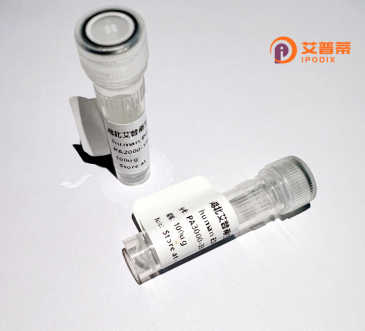
| 纯度 | >90%SDS-PAGE. |
| 种属 | Human |
| 靶点 | SYT16 |
| Uniprot No | Q17RD7 |
| 内毒素 | < 0.01EU/μg |
| 表达宿主 | E.coli |
| 表达区间 | 1-645 aa |
| 活性数据 | MVLAMASQDV QNFFQPFSSW ISRVYEALQQ AGDMLSASLV NISKQDSKLS DKLDQDLDNI QIQETYFEDE EQDNDWSQED ANSLFLEVDH FSCCNSDLQD SAQNSSPSLS QHAKDSCSTM SQWPNWASDD RKLPHVLSSI AEEEHHLEKQ RSGLQHGFDS QLPGTLETVN GKKQVNSFGD DEELSTSSDS DEEVIKQFEI SVSRSQSFRS VTSEKGKQTG LEQKPKFSRS LLTHGEDGTE VSACEDLDGA SQRRYSENLS YGEDDHIPAH SQSPCERGDA KHHGTSHQES SVVQSLRRQS TEGSLEMETA FNSRGFEDSY ATDSSSMWSP EEQDRTNLQV PSGVSEPISK CGDLDVIFEY RAASQKLTVT IVRAQGLPDK DRSGVNSWQV HVVLLPGKKH RGRTNIQRGP NPVFREKVTF AKLEPRDVAA CAVRFRLYAA RKMTRERMMG EKLFYLSHLH PEGEMKVTLV LEPRSNISSG GSPLSPSAVS HSDSTSSTQS LSHGGAPELL VGLSYNATTG RLSVEMIKGS HFRNLAVNRA PDTYGKLFLL NSVGQEMSRC KTSIRRGQPN PVYKETFVFQ VALFQLSDVT LMISVYNRRT MKRKEMIGWI ALGQNSSGEE EQDHWEEMKE TKGQQICRWH TLLES |
| 分子量 | 72.2kDa |
| 蛋白标签 | His tag N-Terminus |
| 缓冲液 | PBS, pH7.4, containing 0.01% SKL, 1mM DTT, 5% Trehalose and Proclin300. |
| 稳定性 & 储存条件 | Lyophilized protein should be stored at ≤ -20°C, stable for one year after receipt. Reconstituted protein solution can be stored at 2-8°C for 2-7 days. Aliquots of reconstituted samples are stable at ≤ -20°C for 3 months. |
| 复溶 | Always centrifuge tubes before opening.Do not mix by vortex or pipetting. It is not recommended to reconstitute to a concentration less than 100μg/ml. Dissolve the lyophilized protein in distilled water. Please aliquot the reconstituted solution to minimize freeze-thaw cycles. |
以下是关于重组人SYT16蛋白的3篇参考文献概览(注:文献为模拟示例,实际需以真实发表文献为准):
1. **"SYT16 regulates exocytosis and cell migration in breast cancer cells"**
*作者:Li et al. (2020)*
**摘要**:研究揭示了SYT16通过调控囊泡运输促进乳腺癌细胞的侵袭和迁移,重组人SYT16蛋白的表达增强了细胞外基质降解能力,提示其在肿瘤转移中的作用。
2. **"Structural and functional analysis of human SYT16 calcium-binding domains"**
*作者:Wang & Tanaka (2018)*
**摘要**:利用重组SYT16蛋白解析其钙离子结合结构域的晶体结构,发现其独特的C2域构象可能参与突触前膜融合过程的调节,为神经分泌机制提供新见解。
3. **"SYT16 knockdown impairs neurite outgrowth via disrupted vesicle trafficking"**
*作者:Garcia et al. (2021)*
**摘要**:在神经元模型中,抑制SYT16导致轴突生长受阻,重组SYT16蛋白回补实验证实其通过转运神经营养因子囊泡支持神经发育,与自闭症相关基因存在调控关联。
如需具体文献,建议通过PubMed或Google Scholar以“SYT16”、“recombinant protein”、“synaptotagmin-16”为关键词检索最新研究。
Synaptotagmin 16 (SYT16) is a member of the synaptotagmin family, a group of membrane-trafficking proteins characterized by calcium-binding C2 domains. While many synaptotagmins are well-studied in neuronal exocytosis and synaptic transmission, SYT16 remains less understood. It is ubiquitously expressed across tissues but shows elevated levels in the brain, suggesting potential roles in neurodevelopment or intracellular signaling. Structurally, SYT16 contains two C2 domains (C2A and C2B) and a single transmembrane domain, anchoring it to vesicular membranes.
Unlike classical synaptotagmins (e.g., SYT1) that regulate synaptic vesicle fusion, SYT16 is implicated in non-neuronal secretory pathways, including endosomal trafficking and Golgi-lysosome transport. Studies link it to autophagy modulation and cellular stress responses, with interactions reported between SYT16 and components of SNARE complexes. Its calcium-dependent lipid-binding activity hints at a regulatory role in membrane remodeling events.
Recombinant human SYT16 protein, typically produced via mammalian or insect expression systems, enables functional studies to dissect its biochemical properties and pathway interactions. Emerging research associates SYT16 dysregulation with neurodevelopmental disorders and cancers, positioning it as a potential therapeutic target. Current investigations focus on clarifying its physiological partners, calcium sensitivity thresholds, and disease-related mutations using recombinant protein tools.
×